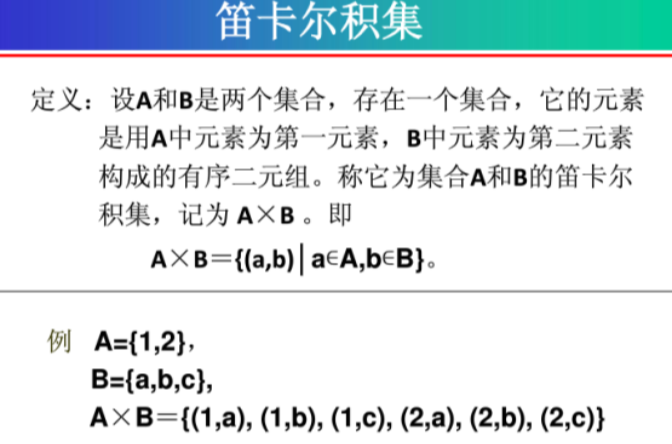背景
笛卡爾1596年3月31日生於法國土倫省萊耳市的一個貴族之家,笛卡爾的父親是布列塔尼地方議會的議員,同時也是地方法院的法官,笛卡爾在豪華的生活中無憂無慮地度過了童年。

笛卡爾1612年到普瓦捷大學攻讀法學,四年後獲博士學位。1616年笛卡爾結束學業後,便背離家庭的職業傳統,開始探索人生之路。他投筆從戎,想藉機遊歷歐洲,開闊眼界。
在荷蘭長達20多年的時間裡,笛卡爾對哲學、數學、天文學、物理學、化學和生理學等領域進行了深入的研究,並通過數學家梅森神父與歐洲主要學者保持密切聯繫。他的主要著作幾乎都是在荷蘭完成的。
1628年,笛卡爾寫出《指導哲理之原則》,1634年完成了以哥白尼學說為基礎的《論世界》。書中總結了他在哲學、數學和許多自然科學問題上的一些看法。1637年,笛卡爾用法文寫成三篇論文《折光學》、《氣象學》和《幾何學》,並為此寫了一篇序言《科學中正確運用理性和追求真理的方法論》,哲學史上簡稱為《方法論》,6月8日在萊頓匿名出版。1641年出版了《形上學的沉思》,1644年又出版了《哲學原理》等重要著作。
1649年冬,笛卡爾應瑞典女王克里斯蒂安的邀請,來到了斯德哥爾摩,任宮廷哲學家,為瑞典女王授課。由於他身體孱弱,不能適應那裡的氣候,1650年初便患肺炎抱病不起,同年二月病逝。終年54歲。1799年法國大革命後,笛卡爾的骨灰被送到了法國歷史博物館。
定義
笛卡爾乘積是指在數學中,兩個
集合X和
Y的笛卡尓積(Cartesian product),又稱
直積,表示為
X×
Y,第一個對象是
X的成員而第二個對象是
Y的所有可能
有序對的其中一個成員。
假設集合A={a, b},集合B={0, 1, 2},則兩個集合的笛卡爾積為{(a, 0), (a, 1), (a, 2), (b, 0), (b, 1), (b, 2)}。
類似的例子有,如果A表示某學校學生的集合,B表示該學校所有課程的集合,則A與B的笛卡爾積表示所有可能的選課情況。A表示所有聲母的集合,B表示所有韻母的集合,那么A和B的笛卡爾積就為所有可能的漢字全拼。
設A,B為集合,用A中元素為第一元素,B中元素為第二元素構成有序對,所有這樣的有序對組成的集合叫做A與B的笛卡爾積,記作AxB.
笛卡爾積的符號化為:
A×B={(x,y)|x∈A∧y∈B}
例如,A={a,b}, B={0,1,2},則
A×B={(a, 0), (a, 1), (a, 2), (b, 0), (b, 1), (b, 2)}
B×A={(0, a), (0, b), (1, a), (1, b), (2, a), (2, b)}
運算
1.對任意集合A,根據定義有
AxΦ =Φ , Φ xA=Φ
2.一般地說,笛卡爾積運算不滿足交換律,即
AxB≠BxA(當A≠Φ ∧B≠Φ∧A≠B時)
3.笛卡爾積運算不滿足結合律,即
(AxB)xC≠Ax(BxC)(當A≠Φ ∧B≠Φ∧C≠Φ時)
Ax(B∪C)=(AxB)∪(AxC)
(B∪C)xA=(BxA)∪(CxA)
Ax(B∩C)=(AxB)∩(AxC)
(B∩C)xA=(BxA)∩(CxA)
案例
給出三個域:
D1=SUPERVISOR = { 張清玫,劉逸 }
D2=SPECIALITY= {計算機專業,信息專業}
則D1,D2,D3的笛卡爾積為D:
D=D1×D2×D3 ={(張清玫, 計算機專業, 李勇), (張清玫, 計算機專業, 劉晨),
(張清玫, 計算機專業, 王敏), (張清玫, 信息專業, 李勇),
(張清玫, 信息專業, 劉晨), (張清玫, 信息專業, 王敏),
(劉逸, 計算機專業, 李勇), (劉逸, 計算機專業, 劉晨),
(劉逸, 計算機專業, 王敏), (劉逸, 信息專業, 李勇),
(劉逸, 信息專業, 劉晨), (劉逸, 信息專業, 王敏)}
這樣就把D1,D2,D3這三個集合中的每個元素加以對應組合,形成龐大的集合群。
本個例子中的D中就會有2X2X3個元素,如果一個集合有1000個元素,有這樣3個集合,他們的笛卡爾積所組成的新集合會達到十億個元素。假若某個集合是
無限集,那么新的集合就將是有無限個元素。
代碼
C#原始碼
using System;using System.Collections;using System.Collections.Generic;using System.Text;using System.Linq;public class Descartes{public static void run(List<List<string>> dimvalue, List<string> result, int layer, string curstring){if (layer < dimvalue.Count - 1){if (dimvalue[layer].Count == 0)run(dimvalue, result, layer + 1, curstring);else{for (int i = 0; i < dimvalue[layer].Count; i++){StringBuilder s1 = new StringBuilder();s1.Append(curstring);s1.Append(dimvalue[layer][i]);run(dimvalue, result, layer + 1, s1.ToString());}}}else if (layer == dimvalue.Count - 1){if (dimvalue[layer].Count == 0) result.Add(curstring);else{for (int i = 0; i < dimvalue[layer].Count; i++){result.Add(curstring + dimvalue[layer][i]);}}}}}使用說明
(1)將每個維度的集合的元素視為List<string>,多個集合構成List<List<string>> dimvalue作為輸入
(2)將多維笛卡爾乘積的結果放到List<string> result之中作為輸出
(3)int layer, string curstring只是兩個中間過程的參數攜帶變數
(4)程式採用遞歸調用,起始調用示例如下:
List<string> result = new List<string>();
Descartes.run(dimvalue, result, 0, "");
即可獲得多維笛卡爾乘積的結果。
JAVA原始碼
import java.util.ArrayList;import java.util.List;//import com.alibaba.fastjson.JSON;public class DescartesUtil { public static void main(String[] args) { List<List<String>> list = new ArrayList<List<String>>(); List<String> listSub1 = new ArrayList<String>(); List<String> listSub2 = new ArrayList<String>(); List<String> listSub3 = new ArrayList<String>(); List<String> listSub4 = new ArrayList<String>(); listSub1.add("1"); listSub1.add("2"); listSub2.add("3"); listSub2.add("4"); listSub3.add("a"); listSub3.add("b"); listSub4.add("c"); listSub4.add("d"); list.add(listSub1); list.add(listSub2); list.add(listSub3); list.add(listSub4); List<List<String>> result = new ArrayList<List<String>>(); descartes(list, result, 0, new ArrayList<String>()); // System.out.println(JSON.toJSONString(result)); } /** * Created on 2014年4月27日 * <p> * Discription:笛卡爾乘積算法 * 把一個List{[1,2],[3,4],[a,b]}轉化成List{[1,3,a],[1,3,b],[1,4 * ,a],[1,4,b],[2,3,a],[2,3,b],[2,4,a],[2,4,b]}數組輸出 * </p> * * @param dimvalue原List * @param result通過乘積轉化後的數組 * @param layer * 中間參數 * @param curList * 中間參數 */ private static void descartes(List<List<String>> dimvalue, List<List<String>> result, int layer, List<String> curList) { if (layer < dimvalue.size() - 1) { if (dimvalue.get(layer).size() == 0) { DescartesUtil.descartes(dimvalue, result, layer + 1, curList); } else { for (int i = 0; i < dimvalue.get(layer).size(); i++) { List<String> list = new ArrayList<String>(curList); list.add(dimvalue.get(layer).get(i)); DescartesUtil.descartes(dimvalue, result, layer + 1, list); } } } else if (layer == dimvalue.size() - 1) { if (dimvalue.get(layer).size() == 0) { result.add(curList); } else { for (int i = 0; i < dimvalue.get(layer).size(); i++) { List<String> list = new ArrayList<String>(curList); list.add(dimvalue.get(layer).get(i)); result.add(list); } } } }}python原始碼
from itertools import productfor x,y,z in product(['a','b','c'],['d','e','f'],['m','n']): print(x,y,z)



